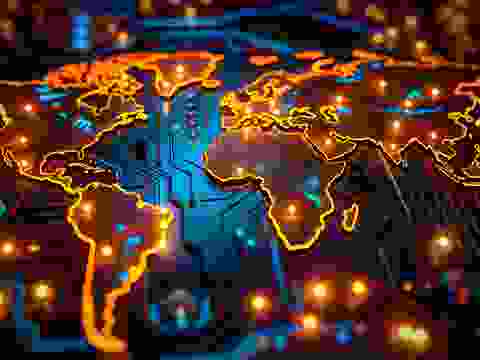Chile Antarctic Territory Claim
Critical minerals, policy, and the energy transition
The Energy Transition in Chile's Antarctic Territory Claim
The Chilean Antarctic Territory occupies a geopolitically and environmentally significant part of the southernmost continent, where the accelerating global demand for critical minerals, used in wind turbines, solar panels, and electric vehicles—has heightened interest in Antarctica’s long-term strategic value. While the Antarctic Treaty System, including the 1959 Antarctic Treaty, prohibits commercial mineral exploitation, Chile’s claim overlaps with those of Argentina and the United Kingdom, creating a delicate balance between suspended sovereignty, international cooperation, and future resource considerations. Chile maintains a continuous presence in the region through its research stations and logistical infrastructure, reinforcing its role as both a scientific contributor and a stakeholder in Antarctic governance. As interest in supply chain resilience and mineral security grows, questions around treaty durability, environmental protection, and geopolitical alignment become increasingly salient. The Chilean Antarctic Territory thus sits at a complex intersection of science, sovereignty, and sustainability, offering insight into how claimant nations may navigate the pressures of the global energy transition within a framework of peace and environmental responsibility.
Sovereignty, Science, and Stewardship in a Contested Region
Chile’s Antarctic Territory is one of the most prominent and contested claims in Antarctica. Encompassing a vast wedge-shaped region from the South Pole to the southern oceans, it forms a core part of Chile’s identity as a tricontinental nation. The territory is embedded in a complex web of overlapping claims, scientific exploration, and environmental stewardship. Its strategic importance continues to shape Chile’s foreign policy, scientific priorities, and role in international Antarctic governance.
Chile’s geographic proximity positions it as a gateway nation to Antarctica. Punta Arenas, located at South America’s southern tip, is a major departure point for scientific expeditions, tourism, and logistics. Chile’s claim spans from 53°W to 90°W and from the South Pole to 60°S, covering approximately 1,250,257.6 km²—about 62% of Chile’s total claimed territory. It includes the South Shetland Islands, Antarctic Peninsula (Tierra de O'Higgins), Alexander Island, Charcot Island, and part of Ellsworth Land.
Chile’s Antarctic claim has deep historical roots extending back to the Spanish colonial era. In 1539, King Charles V of Spain granted a capitulación (governorship) to Pedro Sánchez de la Hoz, which included lands south of the Strait of Magellan. This claim passed to Pedro de Valdivia in 1540 and was incorporated into Chile by 1555. Chile views this as establishing an animus occupandi (intention to occupy), rooted in the Inter caetera bull (1493) and the Treaty of Tordesillas (1494).
Chile began formally asserting its Antarctic authority in 1893 by issuing whaling, hunting, and fishing licences, prompting diplomatic protests. In response to Norway’s 1939 claim to Queen Maud Land, President Pedro Aguirre Cerda commissioned a formal review, culminating in Presidential Decree No. 1747 on 6 November 1940, officially creating the Chilean Antarctic Territory.
A defining milestone came in 1948 when President Gabriel González Videla became the first head of state to visit Antarctica, inaugurating Base General Bernardo O'Higgins Riquelme. More recently, in January 2025, President Gabriel Boric became the first Latin American leader to reach the South Pole—reaffirming Chile’s long-term commitment to its Antarctic claim.
President Boric has emphasised strengthening infrastructure and international partnerships to reinforce this strategic role. Chile’s gateway position enhances its geopolitical influence, economic opportunities, and leadership in Antarctic logistics.
Administratively, the territory forms the Antártica commune, part of the Antártica Chilena Province within the Magallanes y la Antártica Chilena Region. It is governed from Puerto Williams on Navarino Island by the Cabo de Hornos municipality. According to the 2012 census, the population was just 115—comprising 100 men and 15 women. The civilian hub is Villa Las Estrellas, located on King George Island, supporting essential infrastructure and services.
Chile maintains a significant and sustained presence across its Antarctic claim. It operates 13 active bases, including four permanent stations, five seasonal facilities, and four shelters. Among the permanent facilities, the Professor Julio Escudero Station is a leading centre for Antarctic research on ecosystems, climate, and earth sciences. Yelcho Base, established in 1962, focuses on marine biodiversity and environmental monitoring. These assets ensure Chile maintains a year-round presence, essential for both scientific advancement and effective occupation.
The Chilean Navy, particularly through the icebreaker Almirante Viel, provides crucial logistical support, enabling consistent access to remote Antarctic sites and strengthening Chile's strategic mobility across its territory.
Chile’s claim exists within one of Antarctica’s most geopolitically sensitive zones. It overlaps with Argentina’s claim (25°W to 74°W, formalised in 1946) and the United Kingdom’s claim (20°W to 80°W, reorganised in 1962 as the British Antarctic Territory). This triangular overlap on the Antarctic Peninsula represents the most contested area on the continent.
The Antarctic Treaty System (ATS), in effect since 1961, freezes all territorial claims—neither recognising nor rejecting them—and restricts activity to peaceful scientific purposes. Chile operates within this framework, asserting sovereignty through presence while engaging in cooperative governance. Chile’s dual approach, affirming its historical claim while actively participating in the ATS has allowed it to protect national interests while upholding Antarctica’s demilitarised and research-focused character.
Scientific research is central to Chile’s Antarctic policy. The Chilean Antarctic Institute (INACH), established in 1963, oversees over 100 research projects involving more than 350 scientists—about 20% of whom are engaged in international collaborations.
Chile is a strong advocate for environmental protection, particularly under the Madrid Protocol (1991), which prohibits mineral resource exploitation. Chile supports the establishment of marine protected areas across the Southern Ocean to safeguard biodiversity and climate research. At research hubs like Yelcho Base, Chile has deployed climate sensor networks, conducted pollution and intertidal ecosystem studies, and led initiatives under the Antarctic Climate Change Observatory. These efforts advance global scientific understanding while reinforcing Chile’s claim. Chile also strengthens scientific diplomacy through agreements, such as the 2023–2028 letter of intent with the United Kingdom on Antarctic cooperation. Such partnerships boost Chile’s international standing and deepen collaborative research.
Chile faces growing challenges in Antarctica. Climate change is transforming the physical environment, complicating logistics and access to critical sites. At the same time, interest from emerging powers, such as China, adds new geopolitical complexities. Chile has responded by reinforcing diplomatic engagement and maintaining physical presence across its territory. It continues to oppose resource exploitation, with President Boric explicitly rejecting commercial mining in line with the Madrid Protocol.


Source: SFA (Oxford)





Meet the Critical Minerals team
Trusted advice from a dedicated team of experts.

Henk de Hoop
Chief Executive Officer

Beresford Clarke
Managing Director: Technical & Research

Jamie Underwood
Principal Consultant

Ismet Soyocak
ESG & Critical Minerals Lead

Rj Coetzee
Senior Market Analyst: Battery Materials and Technologies

How can we help you?
SFA (Oxford) provides bespoke, independent intelligence on the strategic metal markets, specifically tailored to your needs. To find out more about what we can offer you, please contact us.